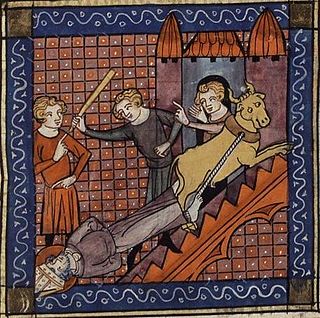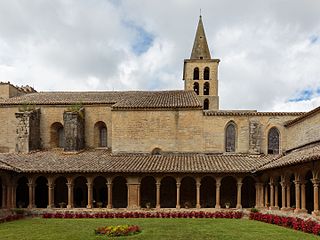Related Research Articles

Sabine Baring-Gould of Lew Trenchard in Devon, England, was an Anglican priest, hagiographer, antiquarian, novelist, folk song collector and eclectic scholar. His bibliography consists of more than 1,240 publications, though this list continues to grow.

Fermin was a holy man and martyr, traditionally venerated as the co-patron saint of Navarre, Spain. He was born in the mid 3rd century, so his death may be associated with the Diocletianic Persecution (303).

Saturnin of Toulouse was one of the "Apostles to the Gauls" sent out during the consulate of Decius and Gratus (250–251) to Christianise Gaul after the persecutions under Emperor Decius had all but dissolved the small Christian communities. Fabian sent out seven bishops from Rome to Gaul to preach the Gospel: Gatien to Tours, Trophimus to Arles, Paul to Narbonne, Saturnin to Toulouse, Denis to Paris, Austromoine to Clermont, and Martial to Limoges. His feast day is 29 November.

February 10 - Eastern Orthodox liturgical calendar - February 12

June 2 - Eastern Orthodox Church calendar - June 4

Gwinear, Guigner, was a Celtic martyr, one of only two early Cornish saints whose biographies survived the Reformation. The Life of Gwinear was written in the early 14th century by a priest named Anselm, and has sometimes been printed among the works of Anselm of Canterbury. His feast day is March 23.

February 5 - Eastern Orthodox liturgical calendar - February 7

February 14 - Eastern Orthodox liturgical calendar - February 16

February 15 - Eastern Orthodox liturgical calendar - February 17

Saint Praxedes, called "a Roman maiden", was a saint and virgin who lived in the Roman Empire during the 2nd century. Along with her sister, Saint Pudentiana, she provided for the poor and gave care and comfort to persecuted Christians and martyrs. Her veneration began in the 4th century and many churches have been dedicated to her.

Landrada of Austrasia was a German saint and ascetic. She co-founded Munsterbilsen Abbey, which was dedicated to the Virgin Mary. Landrada's feast day is 8 July. She is the patroness saint of Munsterbilsen and Ghent.

Saint-Papoul Cathedral was a Roman Catholic church located in the village of Saint-Papoul in Languedoc. The cathedral is dedicated to Saint Papulus, an early Christian bishop and martyr, from whom the settlement also took its name.

The Archdiocese of Toulouse is a Latin Church ecclesiastical territory of the Catholic Church in France. The diocese comprises the Department of Haute-Garonne and its seat is Toulouse Cathedral. Archbishop Guy de Kerimel has been its head since 2021.
Saints Felinus and Gratian(us) (sometimes Gratinian(us)) (d. 250 AD) are venerated as martyrs by the Catholic and Eastern Orthodox churches. They are patron saints of Arona, near Milan, where their relics were enshrined.

Saints Secundian(us), Marcellian and Verian are venerated as Christian saints. They were martyred in 250 AD near Civitavecchia or Santa Marinella during the persecutions of Decius. Secundian was a senator or some sort of prominent official; Marcellian and Verian were scholars or students. Their feast day is August 9.
Luperculus is venerated as a saint by the Roman Catholic Church. Christian tradition states that he was a bishop of Eauze and was martyred by the governor Dacian during the reign of Decius. He was traditionally the second in that episcopal see, the first bishop being Paternus.

Engratia is venerated as a virgin martyr and saint. Tradition states that she was martyred with eighteen companions in 303 AD.

Saint Honestus was, according to Christian tradition, a disciple of Saturninus of Toulouse and a native of Nîmes.

Theodora of Alexandria was a saint and martyr who lived during the 5th century in Alexandria, during the reign of Emperor Zeno. Hagiographer Sabine Baring-Gould states that Theodora's story might have been embellished and that her biography was probably pieced together from the lives of other saints, such as Marina the Monk, another 5th century Byzantine saint who also lived as a male among monks, was accused of the same things as Theodora, and was vindicated after her death.

October 15 - Eastern Orthodox liturgical calendar - October 17
References
- 1 2 abbaye de Saint-Papoul Archived 2007-11-02 at the Wayback Machine
- ↑ Lives of the Saints, November 29, Saint Saturninus
- ↑ Sabine Baring-Gould, The Lives of the Saints (J. Hodges, 1880), 65
- ↑ Sabine Baring-Gould, The Lives of the Saints (J. Hodges, 1880), 65.
- ↑ CATHOLIC ENCYCLOPEDIA: Carcassonne